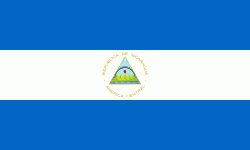San Francisco de Cuapa (Municipio de San Francisco de Cuapa)
San Francisco de Cuapa is a municipality in the Chontales Department of Nicaragua. This municipality was created July 30, 1997 and is located in the northeast section of Chontales. Before that date, the town was part of the municipality of Juigalpa. Its area is about 277 km². The principal business activity is the cattle and agriculture. 99% of the population is Catholic. The first mayor was Manuel Antonio Zelaya Meneses and the vice-mayor was Oscar Velasquez Gonzalez. They were elected in 1997.
In 1980, Bernardo Martínez, sacristan, claimed to have a series of visions of the Virgin Mary. According to Bernardo, this began on April 15 when he saw a strange light emanating from a statue of the Virgin Mary in the parish church. In May, when walking through the fields, he claimed that he saw a vision of the Virgin Mary, who encouraged him to pray the rosary and promote peace saying: "Make Peace. Don't ask Our Lord for peace because, if you do not make it, there will be no peace."
At this time, Nicaragua was going through a civil war. The Sandinista government was facing armed opposition from the Contras. Bernardo Martinez claimed that the Virgin Mary ordered him to burn bad books, which was interpreted to mean Marxist books. The auxiliary Bishop of Managua complied with this request. Sandinista commentators responded by describing the apparition as 'St. Mary of the Contras', 'Our Lady of Oliver North and Our Lady of Cuapa.
On November 13, 1982, the Bishop of Juigalpa released an official statement as Bishop of the area where the apparitions took place assuring the faithful of the authenticity of the events. The apparitions at San Francisco de Cuapa are thus among the few Marian apparitions approved by the Catholic Church in the twentieth century.
In 2005, Silvio Sirias wrote a novel, Bernardo and the Virgin based on these events.
In 1980, Bernardo Martínez, sacristan, claimed to have a series of visions of the Virgin Mary. According to Bernardo, this began on April 15 when he saw a strange light emanating from a statue of the Virgin Mary in the parish church. In May, when walking through the fields, he claimed that he saw a vision of the Virgin Mary, who encouraged him to pray the rosary and promote peace saying: "Make Peace. Don't ask Our Lord for peace because, if you do not make it, there will be no peace."
At this time, Nicaragua was going through a civil war. The Sandinista government was facing armed opposition from the Contras. Bernardo Martinez claimed that the Virgin Mary ordered him to burn bad books, which was interpreted to mean Marxist books. The auxiliary Bishop of Managua complied with this request. Sandinista commentators responded by describing the apparition as 'St. Mary of the Contras', 'Our Lady of Oliver North and Our Lady of Cuapa.
On November 13, 1982, the Bishop of Juigalpa released an official statement as Bishop of the area where the apparitions took place assuring the faithful of the authenticity of the events. The apparitions at San Francisco de Cuapa are thus among the few Marian apparitions approved by the Catholic Church in the twentieth century.
In 2005, Silvio Sirias wrote a novel, Bernardo and the Virgin based on these events.
Map - San Francisco de Cuapa (Municipio de San Francisco de Cuapa)
Map
Country - Nicaragua
 |
 |
| Flag of Nicaragua | |
Originally inhabited by various indigenous cultures since ancient times, the region was conquered by the Spanish Empire in the 16th century. Nicaragua gained independence from Spain in 1821. The Mosquito Coast followed a different historical path, being colonized by the English in the 17th century and later coming under British rule. It became an autonomous territory of Nicaragua in 1860 and its northernmost part was transferred to Honduras in 1960. Since its independence, Nicaragua has undergone periods of political unrest, dictatorship, occupation and fiscal crisis, including the Nicaraguan Revolution of the 1960s and 1970s and the Contra War of the 1980s.
Currency / Language
| ISO | Currency | Symbol | Significant figures |
|---|---|---|---|
| NIO | Nicaraguan córdoba | C$ | 2 |
| ISO | Language |
|---|---|
| EN | English language |
| ES | Spanish language |















